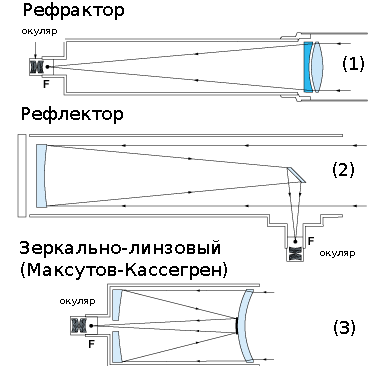
Telescopes
Telescopes. What telescope to buy?
Telescope - a tool for observing astronomical objects. C using the telescope to observe the planets, comets, the Moon, and other objects such as star clusters, galaxies, etc.
- Accessories to telescopes (23)
- Astronomical binoculars (20)
- Telescopes Sturman (17)
-

Universal photoadapter intended for the joint use of optical observation devices (telescope, microscope, monocular, binoculars or telescope) with compact digital cameras.
- Maximum permissible length of the lens — 50 mm;
- Diameter of the eyepiece is 25 to 45 mm;
- Maximum load — 2 kg;
- Tripod mounting, outer diameter is 1/4 inch. -

Adapter Kenko T-mount for Nikon is designed for mounting lenses with threaded connection standard T-mount digital cameras with Nikon F mount, also it can be used to connect elements of the system MILTOL threaded T-mount (lenses, teleconverters, ocular attachment).
- Thread diameter — 42 mm, thread pitch is 0.75 mm;
- Working distance — 46.5 mm;
- Dimensions — 54,2x6,7 mm, weight — 2.2 g;
- 1 year warranty. -

Camera telescope Sturman Solar system's CMOS (b/W) for studying, photo and video objects in the Solar system:
- Black-and-white sensor on the basis of CMOS of a matrix, sensitivity 1.0 v/Lux-sec
- Video 640x480 (VGA)
- Bore diameter of 1.25” (31.75 mm) and inner threads for mounting additional accessories;
- Interface: USB 2.0;
- Supported operating systems – Microsoft Windows XP, Vista, 7 (x32 and x64). -

Powerful field binoculars 20x50 Sturman green for ground-based observations because of the highly remote objects
- Magnification 20x diameter of lens - 50 mm
- Field of view is 3.2° (56 m/1000m)
- Porro prism glass Bk-7
Multi - layer coating of the lenses
The Central focus at a distance of 10 m
- Rubber-coated housing made of aluminium alloy, color green
- Mounted on a tripod via adapter (optional)
- Comes with protective caps, shoulder strap and case -

Binoculars Sturman 7x50 green for hunting and nature observation, elementary astronomical observations
- Increase 7x, diameter of lens - 50 mm
- Field of view - 8° (140 m/1000m), exit pupil diameter - 23 mm
- Porro prism glass Bk-7
Multi - layer coating of the lenses
The Central focus at a distance of 4 m
- Rubber-coated housing made of aluminium alloy and impact resistant plastic, color – green
- Tripod mounting via adapter (sold separately)
- Comes with a protective cap, case and strap -

Binoculars Sturman 7x50 camouflage for hunting and nature observation, elementary astronomical observations
- Increase 7x, diameter of lens - 50 mm
- Field of view - 8° (140 m/1000m), exit pupil diameter - 23 mm
- Porro prism glass Bk-7
Multi - layer coating of the lenses
The Central focus at a distance of 4 m
- Rubber-coated housing made of aluminium alloy and impact resistant plastic, color camouflage
- Tripod mounting via adapter (sold separately)
- Comes with a protective cap, case and strap -

Field glasses Sturman 20x60 green for terrestrial or astronomical observations because of the highly remote objects
- Magnification 20x, lens diameter 60 mm
- The field of view of 3.4° (59,6 m/1000m), exit pupil diameter - 9 mm
- Porro prism glass Bk-7
Multi - layer coating of the lenses
The Central focus at a distance of 5 m
- Rubber impact-resistant housing made of aluminum alloy, colour - camouflage (khaki)
- Mounted on a tripod via adapter (optional)
- Comes with protective caps, shoulder strap and case -

Binoculars Sturman 7x50 WP WA for hunting, fishing and boating
- Increase 7x, diameter of lens - 50 mm
- The field of view of 7.2° (128 m/1000m), exit pupil diameter - 17 mm
- Porro prism glass BaK-4
Multi - layer coating of the lenses
The Central focus at a distance of 8 m
- Waterproof rubber housing-aluminum alloys, turn-and-slide eyecups
- Installation on a tripod using adapter (sold separately)
- Comes with a linked covers lenses and eyepieces, case and strap -

Digital camera for telescope ToupCam GCMOS01200KPB for astrophotography and guiding.
- Color sensor AR0130 with the size of the matrix 1/3“ (4.8 mm x 3.6 mm)
- The pixel size of 3.75 x 3.75 µm
- Exposure time of 0.4 MS -15 C
- Frame rate – 28 fpc (1280x960) and 30 fpc (640x480)
- The ratio signal/noise 44 dB
- Support Windows 10 (32 and 64 bit), Mac OS, Linux, ASCOM
Is the diameter of the eyepieces is 31.75 mm (1.25") threaded mount C-Mount
- Complete cable USB2.0, cable guidance ST4 adapter for filters of 1.25", a CD-ROM with drivers and software -

Spotting scope MIL TOL 200mm F/4 CEF has a secondary application as a high-quality telephoto lens and fits under bayonet mount Canon digital cameras. Used optical design – refractor (4 lenses in 2 groups). Focal length - 200 mm, manual focus, macro mode – maximum scale of 1:6.6 with a maximum aperture of f/4.0. Tripod adapter, diameter under the filter of 55 mm, the size of the product 151х69 mm Guarantee 10 years





















